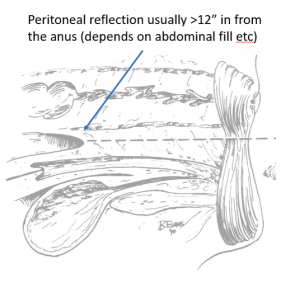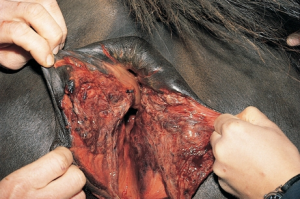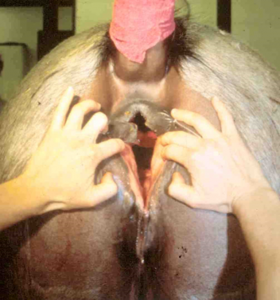Female urogenital surgery
Rectovaginal lacerations
Rectovaginal tears generally occur with parturition and result in three main levels of injury
- injury to the vulva only (type I)
- injury to the vulva and perineal body (type II)
- injury to the roof of the vagina (perineal body included) and floor of the rectum (type III)
Therapy
Type I tears are treated by Caslick’s procedure.
Type II tears are treated by perineal body reconstruction and Caslick’s procedure.
Type III tears are treated by reconstruction of the two tubes (vagina and rectum) plus perineal body reconstruction and Caslicks. This is typically a referral procedure although it can be performed in the field by an experienced surgeon. The laceration does NOT extend into the peritoneal cavity in most situations.



For initial care, animals generally require NSAIDs and often antibiotic therapy due to local tissue damage. For cattle, this is typically flunixin meglumine and ceftiofur or similar antibiotic. For horses, this is typically either flunixin meglumine or phenylbutazone and trimethoprim sulfa.
Due to the amount of tissue trauma, it is pointless to repair these at the time they occur. The high degree of blunt trauma results in continued tissue deterioration and any sutures placed will dehisce in 2-3 days. Granulation tissue develops in 5 days and is mostly vessels. Granulation tissue does not hold suture. While the vulva and perineal body can often be repaired at 2-4 weeks post-injury, type III tear repair requires fibrous tissue to be present and should be delayed until 4-6 weeks after injury.
Type III tears are challenging to repair due to the high bacteria levels in the rectum and vagina, presence of collagenase producing bacteria in the feces, and, in horses, firm fecal balls. Mares should be on a laxative diet and have soft feces prior to repair. If the foal is alive and nursing, repair should be delayed until after the foal is weaned. It is unreasonable to expect a mare to produce enough milk on the adjusted diet. Cattle usually have soft feces so dietary change is not needed.
Prognosis is actually very good with appropriate repair. While the vagina does get contaminated until the tear is fixed, it can rapidly clear the inflammation during the next heat cycle. The rectum and vagina typically heal quickly. The biggest issue is fistula formation due to tension on the repair. Second repair attempts are commonly needed.
Resources
Urogenital surgery with the mare standing, VCNA 2014 -details at the end of the article; just if interested

